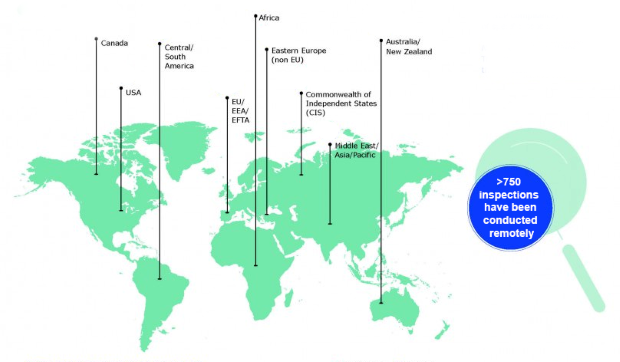
As with all areas of the Agency, the start of lockdown this time last year meant a complete change to the way of working for the inspectorate, with the potential to impact dramatically on our ability to maintain regulatory oversight of public health.
Inspectors spend a huge chunk of their working time away from the office, out on a variety of sites including pre-clinical sites, manufacturing facilities, clinical trial sites, pharmaceutical company offices and medicines distribution sites. With our whole fleet of inspectors grounded, swift action in innovating the way we inspect was required.
Since the start of lockdown we have now carried out over 750 inspections conducted remotely across the Good Practice Standards (GxPs), a huge achievement given both the pandemic restrictions and also juggling with caring and childcare responsibilities, both on the part of the inspectors and those we are required to inspect. The MHRA inspectorate has maintained an international perspective on our remote inspections, sharing our experiences through the International Coalition of Medicines Regulatory Authorities (ICMRA) and Pharmaceutical Inspection Co-operation Scheme (PIC/S), including training other regulators in our approaches.

So how have we achieved this?
While we were already conducting some activities remotely pre-pandemic - such as ‘Day 1’ of the inspection involving remote data review and accessing electronic systems - most of our inspections were on site. Working as a team across the inspectorate, experiences were shared resulting in the implementation of a variety of methods to enable regulatory oversight of patient and public health and security of the global supply chain. This has included changing ways of working that we will continue to conduct post-pandemic, including desk top assessments for low risk organisations, and amending the way we operate our Inspection Action Group for critical findings to ensure that inspectors are not in a cycle of re-inspecting sites that are not yet in compliance.
Digital developments
Due to the agile approach of inspectors, and willingness to adapt quickly to the different landscape we were working in, within the first month remote inspections were taking place in all areas. A variety of file-share platforms have been used, including those already established in the companies inspected, as well as FileShare and, more recently, Teams Channels. Teams channels can now be set up for every inspection and allows sharing of large data files, as well as providing a space for inspectors to discuss inspections with the companies, replicating the inspection team being ‘in the room’ together as far as possible. This has only been possible through the amazing support from our technology services teams.
The future of inspections – innovate, innovate, innovate
So where do we see this going? One of the unexpected outcomes of remote inspections, is that they actually take longer to perform than the on-site model due to the limitations (even with technology) of not having that real time presence of questions raised and answered or being able to ‘dig around’ to see what the compliance level of a facility is really like. As Chair of the ICMRA Covid-19 working group on the Digital Transformation of Inspections, I have found the consensus view across global regulators is that working remotely is a great ‘tool’ in our inspection toolkit, but will never replace what can be achieved in person – and there are many areas that are just not suitable for remote approaches, such as sterile facilities – this is particularly relevant at the moment as we work closely across the Divisions on vaccines.
The inspectorate also performs a significant number of inspections overseas to ensure the quality and safety of medicines supplied to the UK. Despite vaccines roll-out it will be some time before we are able to return to those sites.
Moving forward, our inspectors will therefore continue to innovate, with our focus currently on incorporating ‘visual technologies’ into our toolbox, which will enable us to have some level of ‘eyes on site’ for those areas where it is critical to see the facility or clinic where the work takes place.
This provides an opportunity to break new ground in ensuring that patients and the public receive only those medicines with the quality and safety we would expect, whatever emergency situation we find ourselves in.
Links to blogs on our pandemic inspection approaches can be found here & here and our guidance on inspections here
Don’t miss the next post, sign up to be notified by email when a new post comes out.

